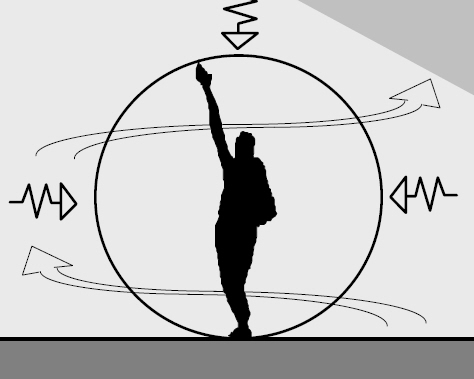Environment
Contents |
[edit] Introduction
In its broadest sense, the term ‘environment’ refers to all of the things around us. These things can affect our comfort, wellbeing, performance, behaviour, growth and development. In turn, our behaviour can impact on the environment around us.
In a very general way, the environment can be considered to comprise:
- The natural environment.
- The built environment.
[edit] The natural environment
The term 'natural environment' refers to the non-human-made surroundings and conditions in which all living and non-living things exist. The common concept of the natural environment encompasses two different components:
- Ecological units that operate as natural systems (such as soil, vegetation and so on).
- Universal natural resources (such as air and water).
In this sense, the term ‘environmental’ has become synonymous with ‘sustainability’ describing a desire to carry out activities without depleting resources or having harmful impacts, defined by the Brundtland Commission as 'meeting the needs of the present without compromising the ability of future generations to meet their own needs.' (ref. Brundtland Commission, Our Common Future, 1987).
For more information see: Natural environment.
[edit] The built environment
The term ‘built environment’ refers to aspects of our surroundings that are built by humans. It includes not only buildings, but the human-made spaces between buildings, such as parks, and the infrastructure that supports human activity such as transportation networks, utilities networks, flood defences, telecommunications, and so on.
The built environment is increasingly developed in a way that considers both its resilience to and its impact on the natural environment.
For more information see: Built environment.
[edit] Personal environmental conditions
The way that individuals experience the environment around them comprises a number of different characteristics, including:
- The thermal environment (air temperature, radiant temperature, air velocity and humidity).
- The visual environment (colour, views, lighting levels, glare, visual information and so on).
- The acoustic environment (sound and noise).
- Air quality (pollution, smells and so on)
- Textures.
[edit] Other classifications
Other definitions of the environment include:
- Internal environment.
- External environment.
- Historic environment.
- Ecological environment.
- Macro environment.
[edit] Business definition
The term 'environment' may also be used to describe the conditions within which a business operates. This can include the internal environment within the business itself, and the external environment outside the business that affects its activities. Typically the external environment is broken down into a micro environment and a macro environment.
The term 'environment' is also used in relation to computer coding to describe the development environment.
[edit] Related articles on Designing Buildings
- Air quality.
- Built environment.
- External environment.
- Historic environment.
- Indoor environmental quality.
- Internal environment.
- Operating environment.
- Macro environment.
- Micro environment.
- Natural environment.
- Sustainability.
- Thermal comfort.
- Thermal environment.
- Wellbeing.
- Environmental impact assessments.
Featured articles and news
Commissioning Responsibilities Framework BG 88/2025
BSRIA guidance on establishing clear roles and responsibilities for commissioning tasks.
An architectural movement to love or hate.
Don’t take British stone for granted
It won’t survive on supplying the heritage sector alone.
The remarkable story of a Highland architect.
The Constructing Excellence Value Toolkit
Driving value-based decision making in construction.
Meet CIOB event in Northern Ireland
Inspiring the next generation of construction talent.
Reasons for using MVHR systems
6 reasons for a whole-house approach to ventilation.
Supplementary Planning Documents, a reminder
As used by the City of London to introduce a Retrofit first policy.
The what, how, why and when of deposit return schemes
Circular economy steps for plastic bottles and cans in England and Northern Ireland draws.
Join forces and share Building Safety knowledge in 2025
Why and how to contribute to the Building Safety Wiki.
Reporting on Payment Practices and Performance Regs
Approved amendment coming into effect 1 March 2025.
A new CIOB TIS on discharging CDM 2015 duties
Practical steps that can be undertaken in the Management of Contractors to discharge the relevant CDM 2015 duties.
Planning for homes by transport hubs
Next steps for infrastructure following the updated NPPF.
Access, history and Ty unnos.
The world’s first publicly funded civic park.
Exploring permitted development rights for change of use
Discussing lesser known classes M, N, P, PA and L.
CIOB Art of Building photo contest 2024 winners
Fresco School by Roman Robroek and Once Upon a Pass by Liam Man.
























